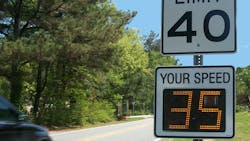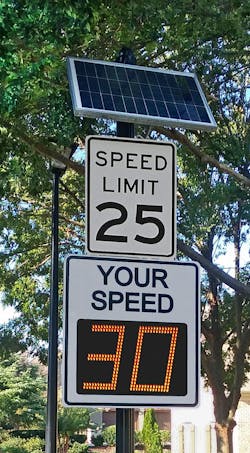Sign Language: How Radar Speeds Signs are Making Roads Safer
When Charlie Robeson and his partners decided to create the company Radarsign close to 20 years ago, they all agreed there was the same problem in all of their neighborhoods: motorists were speeding at alarming rates. Today, the problem hasn’t gone away and in a lot of cases has only gotten worse.
Robeson, who recently retired, and the company’s newly appointed director of sales, William Warwick, spoke to OFFICER Magazine about the role the signs play in alerting drivers and collecting important data for law enforcement.
Managing the problem
While speeding will never go away completely, radar speed signs can play a big role in managing the problem. There are two different types of metrics that the signs measure. One is the average speed. Robeson says that law enforcement agencies are not going to see that number go down by more than 2 or 3 miles per hour after installing a sign. Instead, he says the more important metric is peak speeds—the fastest speed of vehicles that pass by the sign. “Your guys that you would call ‘super-speeders’ that are doing 15, 20 or 25 miles over the limit, they’re the ones that are going to see this thing flashing and then realize what they’re doing, and the vast majority of those people will tap on their breaks and bring it down to a speed that is safer.”
Radar signs are effective because of Feedback Loops. The concept states that if people are provided with information about their actions in real time, they are given an opportunity to change those actions, pushing them toward better behaviors. “The basic premise of all radar signs is that the driver is being given information, the driver sees the information and given the choice to do the right thing or the wrong thing, most people will do the right thing and slow down,” he says. “It just continues to work because of the physics and physiology of having a Feedback Loop.”Because of this, he says that signs that are out in a single place, even for 10 years, continue to be effective.
“These signs have such a tremendous calming effect on people because we live in a digital age where people have become so complacent and looking at these printed speed limit signs,” adds Warwick. “They are looking at their phones, they are not paying attention.”
Gathering information
An important feature of the signs is the ability for law enforcement agencies to collect data. “We have had any number of departments that have invested in these signs and can use them to collect traffic data to determine if there is a speeding problem, how bad is it, what time of day is the worst and which day of the week,” says Robeson. “They then use it to intelligently deploy the reduced staff that almost all of them have at this point. It keeps them from wasting a lot of time in places and times where they don’t necessarily have anybody out there speeding.”
One of the key changes over the years when it comes to data collection is the method of collecting data. The first Radarsign units required the user to take a Palm Pilot and go within one foot of the sign to collect the data wirelessly. That gave way to Bluetooth a few years later, which expanded the range of connectivity to about 30 feet. Just six years ago, Robeson says Radarsign migrated all of its products to Wifi, which allowed its customers to use any type of device that can connect to a wireless network. The range is now 200 to 300 feet, allowing users to collect data from the signs without exiting their vehicles. Today, the company offers a Cloud service that uses is a cellular modem in the sign that uploads the data every night. “Now you can go to the office, log in and there’s the charts and graphs and tables,” he says.
Another key feature, according to Warwick, is “stealth” mode. Available on all of the company’s signs, the agency can turn the display off so it is not lit up, but the sign will still collect data. “They get more ‘real data.’ People may not notice the signs on the pole. They might not respond and react to it and then (the agency) can really see what’s going on there when an officer is not available and turn that sign back on and compare the two in charts, graphs and data.”
Keeping the signs safe
During his initial visits to agencies upon starting the company, Robeson says that he was told that the signs, as they were being built at the time, had a real problem with vandalism. “All it took was a baseball bat and you have a $4,000-$5,000 broken product. We tried to address as many of those issues when we built our first model.”
All of Radarsign’s products have an impact sensor in them, also known as a “Possum Switch.” Warwick stressed that this feature has proven invaluable in keeping the signs safe. “If someone is hitting the sign with a baseball bat or metal rod, that impact sensor can be hit one or more times and it will shut down the sign and basically play dead.”
In 30 minutes the sign will come out of the mode automatically or if the customer wants to take it out of mode quicker, they can do so manually. Warwick says that it sends the message to the person that is doing harm to sign that that they did what they came to do. “When we explain that feature to the police departments and city managers and county managers, they absolutely love it.”
About the Author
Paul Peluso
Editor
Paul Peluso is the Managing Editor of OFFICER Magazine and has been with the Officer Media Group since 2006. He began as an Associate Editor, writing and editing content for Officer.com. Previously, Paul worked as a reporter for several newspapers in the suburbs of Baltimore, MD.


